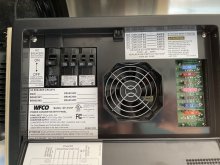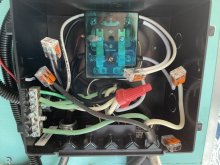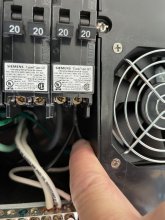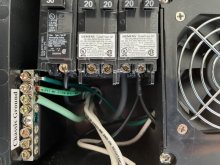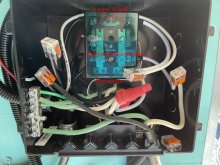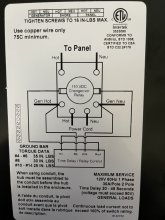So, I should keep doing what I am doing and turn off the last 20amp breaker, that is the converter/charger (my finger pointing to it).
Yes, that works - although your relevant "20A" circuit breaker is definitely branched into two "downstream" circuits (one leading to your regular plugs, presumably through a GFI outlet, and the other leading into WFCO's Power Converter Board. Your fix, to separate the regular 120V outlets from the WFCO, is extremely simple:
Shut off the main 30A breaker. In addition, I recommend that you pull the 30A cord and make sure the Inverter is off, just to be double-sure that no 120-VAC power is reaching that bus. Then, use your volt meter to verify zero "AC" voltage difference between "chassis ground" and the 30A Breaker input lug. You're now
triple sure to be working only with unpowered wires.)
Leave the breaker with the bigger 20A wire (leading to your air conditioner) undisturbed. But, using a #2 square drive screwdriver, loosen your target breaker screw (the last one) and pull out the wire with the "branch" happening about 1/2" down. With that common wire now loose, CUT the wire at the place where the two wires become joined. Strip the now separate ends (stripped length a bit less than 3/8"). Put the smaller wire (the wire for Converter) back into the same Circuit Breaker.
Move the slightly bigger wire (the wire for 120v-outlets) over to one of the empty slots on the first 20A breaker.
- - - -
That's in the short term. In the long term, I recommend that you install a SMALLER breaker (15A x 2) in place of the right-most dual-20A breaker, because your Inverter shouldn't ever need to draw even 15A. And your regular outlets, unless they are T-slotted for 20A appliances, shouldn't support more than 15A either. It also looks like your "downstream" wiring is small - and possibly 14-AWG, rather than 12-AWG. You must never allow "20A" on 14-AWG wire.
After buying that breaker, you again disconnect all input power sources and flip the 30A breaker to "off", and retest. Move the air conditioner "Hot" wire over to one of the left-side Circuit Breaker terminals, And put your remaining smaller wires (the Converter wire and the Outlet wire) into the new 15A breaker ports.
Here's that Breaker, over at Amazon.
https://www.amazon.com/Siemens-Q1515-120-Volt-Breakers-breakers/dp/B00002NB0L/ It is sometimes also an in-stock item at Lowes, and at Home Depot.





